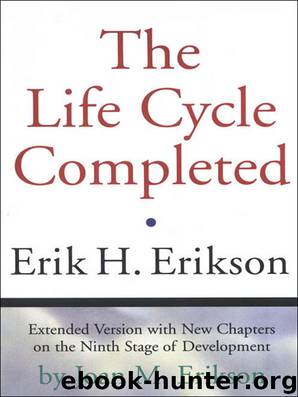The Life Cycle Completed (Extended Version) by Erik H. Erikson

Author:Erik H. Erikson
Language: eng
Format: epub
Publisher: W. W. Norton & Company
Published: 2013-04-23T16:00:00+00:00
* * *
ADOLESCENCE AND SCHOOL AGE
To proceed further back: the reliability of young adult commitments largely depends on the outcome of the adolescent struggle for identity. Epigenetically speaking, of course, nobody can quite “know” who he or she “is” until promising partners in work and love have been encountered and tested. Yet, the basic patterns of identity must emerge from (1) the selective affirmation and repudiation of an individual’s childhood identifications; and (2) the way in which the social process of the times identifies young individuals—at best recognizing them as persons who had to become the way they are and who, being the way they are, can be trusted. The community, in turn, feels recognized by the individual who cares to ask for such recognition. By the same token, however, society can feel deeply and vengefully rejected by the individual who does not seem to care to be acceptable, in which case society thoughtlessly dooms many whose ill-fated search for communality (in gang loyalty, for example) it cannot fathom or absorb.
The antithesis of identity is identity confusion, obviously a normative and necessary experience that can, however, form a core disturbance aggravating and aggravated by pathological regression.
How is the psychosocial concept of identity related to the self—that core concept of individual psychology? As pointed out, a pervasive sense of identity brings into gradual accord the variety of changing self-images that have been experienced during childhood (and that, during adolescence, can be dramatically recapitulated) and the role opportunities offering themselves to young persons for selection and commitment. On the other hand, a lasting sense of self cannot exist without a continuous experience of a conscious “I,” which is the numinous center of existence: a kind of existential identity, then, which (as we noted in discussing old age) in the “last line” must gradually transcend the psychosocial one. Therefore, adolescence harbors some sensitive, if fleeting, sense of existence as well as a sometimes passionate interest in ideological values of all kinds—religious, political, intellectual—including, at times, an ideology of adjustment to the time’s patterns of adjustment and success. Here, the upheavals characterizing the adolescence of other times can remain strangely dormant. And then again, adolescence can harbor existential preoccupations of the kind that can “come of age” only in old age.
The specific strength emerging in adolescence—namely, fidelity—maintains a strong relation both to infantile trust and to mature faith. As it transfers the need for guidance from parental figures to mentors and leaders, fidelity eagerly accepts their ideological mediatorship—whether the ideology is one implicit in a “way of life” or a militantly explicit one. The antipathic counterpart of fidelity, however, is role repudiation: an active and selective drive separating roles and values that seem workable in identity formation from what must be resisted or fought as alien to the self. Role repudiation can appear in the form of diffidence covering a certain slowness and weakness in relation to any available identity potential or in the form of a systematic defiance. This last, is a perverse
Download
This site does not store any files on its server. We only index and link to content provided by other sites. Please contact the content providers to delete copyright contents if any and email us, we'll remove relevant links or contents immediately.
Cecilia; Or, Memoirs of an Heiress — Volume 1 by Fanny Burney(31333)
Cecilia; Or, Memoirs of an Heiress — Volume 3 by Fanny Burney(30934)
Cecilia; Or, Memoirs of an Heiress — Volume 2 by Fanny Burney(30889)
The Great Music City by Andrea Baker(21318)
We're Going to Need More Wine by Gabrielle Union(18074)
Bombshells: Glamour Girls of a Lifetime by Sullivan Steve(13109)
Pimp by Iceberg Slim(12932)
All the Missing Girls by Megan Miranda(12752)
Fifty Shades Freed by E L James(12451)
Norse Mythology by Gaiman Neil(11884)
Talking to Strangers by Malcolm Gladwell(11880)
Crazy Rich Asians by Kevin Kwan(8351)
Mindhunter: Inside the FBI's Elite Serial Crime Unit by John E. Douglas & Mark Olshaker(7834)
The Lost Art of Listening by Michael P. Nichols(6474)
Enlightenment Now: The Case for Reason, Science, Humanism, and Progress by Steven Pinker(6407)
Bad Blood by John Carreyrou(5770)
The Four Agreements by Don Miguel Ruiz(5511)
Weapons of Math Destruction by Cathy O'Neil(5038)
We Need to Talk by Celeste Headlee(4871)
